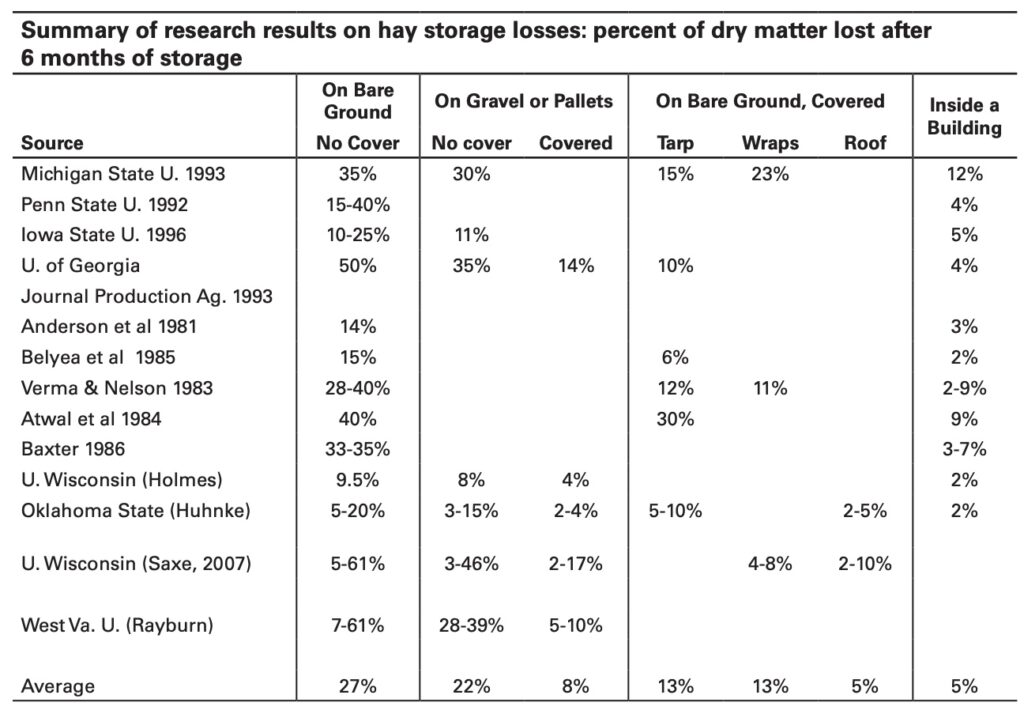Hay Storage: Good, Better, and Best
go.ncsu.edu/readext?953378
en Español / em Português
El inglés es el idioma de control de esta página. En la medida en que haya algún conflicto entre la traducción al inglés y la traducción, el inglés prevalece.
Al hacer clic en el enlace de traducción se activa un servicio de traducción gratuito para convertir la página al español. Al igual que con cualquier traducción por Internet, la conversión no es sensible al contexto y puede que no traduzca el texto en su significado original. NC State Extension no garantiza la exactitud del texto traducido. Por favor, tenga en cuenta que algunas aplicaciones y/o servicios pueden no funcionar como se espera cuando se traducen.
Português
Inglês é o idioma de controle desta página. Na medida que haja algum conflito entre o texto original em Inglês e a tradução, o Inglês prevalece.
Ao clicar no link de tradução, um serviço gratuito de tradução será ativado para converter a página para o Português. Como em qualquer tradução pela internet, a conversão não é sensivel ao contexto e pode não ocorrer a tradução para o significado orginal. O serviço de Extensão da Carolina do Norte (NC State Extension) não garante a exatidão do texto traduzido. Por favor, observe que algumas funções ou serviços podem não funcionar como esperado após a tradução.
English
English is the controlling language of this page. To the extent there is any conflict between the English text and the translation, English controls.
Clicking on the translation link activates a free translation service to convert the page to Spanish. As with any Internet translation, the conversion is not context-sensitive and may not translate the text to its original meaning. NC State Extension does not guarantee the accuracy of the translated text. Please note that some applications and/or services may not function as expected when translated.
Collapse ▲This article was written by Clara Willard, 2023 N.C. Cooperative Extension, Stokes County Center Summer Intern, and reviewed by her intern supervisors.
The two biggest concerns when making a hay storage plan are to maintain the value of the hay and to prevent losses due to spoilage. The value of hay is quantified by several factors that determine overall quality; including the nutrient content. Nutrient content is determined by moisture, temperature, and sunlight. Spoilage, on the other hand, refers to the decay of the hay due to microorganisms.
The best hay will range from 15-20% moisture, or greater than 85 – 80% dry matter (DM). Dry matter content reflects the amount of moisture at harvest and after storage. A dry matter content of at least 80% is an indication that the hay can maintain its quality. However, hay that is too dry can cause palatability issues and nutrients can be lost through leaf shatter. Hay moisture content should not be less than 12%.
A common practice for hay storage is storing outside under a treeline, which is where we will start – “good”. While trees can provide some protection from the elements, they cannot provide sufficient cover from rain and other weather to protect your hay quality. Precipitation can still reach and penetrate the bales, which can lead to mold, and therefore quality and dry matter loss. If you must store your hay outside, consider covering it with a tarp and storing bales on wood pallets or a layer of gravel instead of the ground. Soil contact can also be a reason for dry matter and quality loss, as moisture from the soil can leach into bales. Because of these factors, it is also never ideal to leave baled hay in the hayfield.
When storing hay on pallets, be sure to purchase untreated wood to prevent poisoning your feed supply. Laying down a thinner tarp under your pallets can be helpful in reducing loss of hay, as well as keeping out microorganisms. A thick, vinyl tarp should be used on top. There are some UV treated vinyl tarps that won’t wear down or crack in the sun, but these can trap heat so be mindful of temperatures within the stack, especially when storing hay that may have a moisture content greater than 20%. This is better than storing under a tree line, but not best.
While you can store your hay on pallets outside, storing them in a barn on pallets adds another layer of protection from precipitation and sunlight, and is best. Storing hay in a barn on the ground is another option, but will again allow soil moisture to reach bales. Use caution if storing directly on the floor, as air is prevented from circulating beneath the hay. This lack of ventilation can lead to moisture build-up and create a fire risk.





